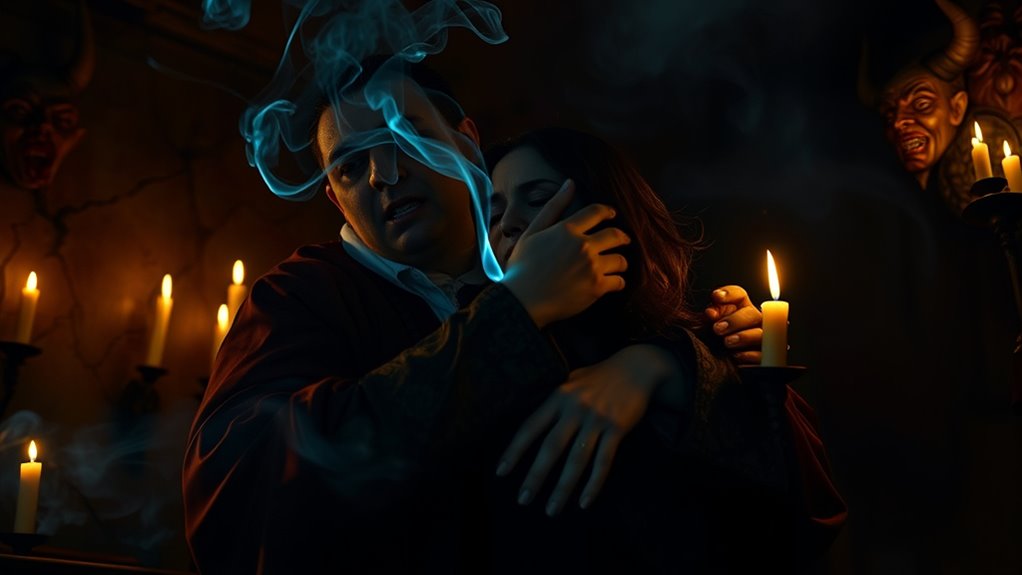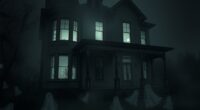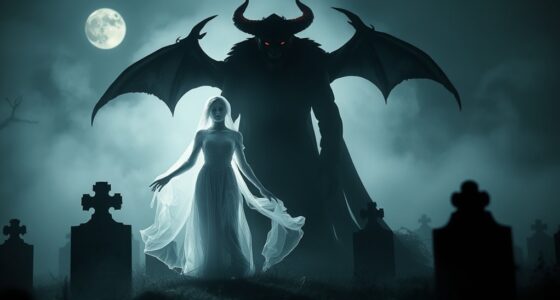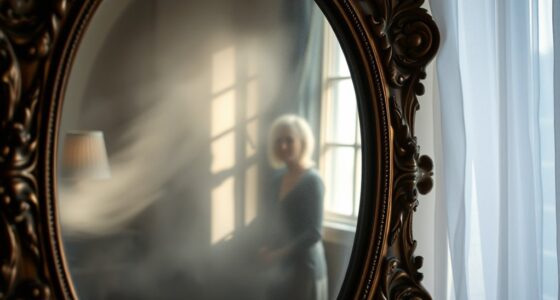Movies often exaggerate demons and exorcisms, portraying them as grotesque monsters engaged in violent battles. These films tend to show demons as nearly invincible villains needing aggressive rituals, which isn’t how real exorcisms work. In truth, spiritual influences are usually subtle, involving thoughts and feelings over time, and focus on faith and prayer. If you’re curious about what movies get wrong about demons, there’s more to uncover below.
Key Takeaways
- Films portray demons as grotesque monsters, whereas real spiritual influence is often subtle and behind-the-scenes.
- Movies depict exorcisms as violent battles; in reality, they involve prayer, faith, and spiritual discipline.
- Cinematic exaggerations make demons seem unstoppable, ignoring their nuanced influence over thoughts and feelings.
- Films often oversimplify demons as pure evil, while real spiritual entities may exert influence gradually and subtly.
- The intense, dramatic visuals in movies distort the true, more compassionate and prayerful nature of authentic exorcisms.

Have you ever wondered if the dramatic stories surrounding exorcisms are mostly true or just exaggerated? Movies and TV shows often paint demons as monstrous, unstoppable forces of evil, but these demon stereotypes can distort reality. Hollywood tends to lean heavily on certain images—grotesque faces, contorted bodies, and sinister voices—that rarely match the nuanced experiences of real exorcisms. Instead of portraying demons as pure evil incarnate, many films take cinematic liberties, heightening their malevolence for dramatic effect. This exaggeration creates a perception that demons are almost invincible, which isn’t always the case in actual spiritual or religious practices.
Cinematic liberties often amplify the fear factor, making demons seem more like supernatural villains straight out of horror fiction. For example, some movies depict demons as invulnerable entities that can only be expelled through violent, gruesome rituals. In reality, exorcists often describe their experiences as more complex and less sensational. They emphasize prayer, compassion, and understanding rather than just brute force or supernatural combat. The exaggerated portrayals can lead viewers to believe that exorcisms are always intense, violent battles, when many are more subtle and prayerful in nature. Furthermore, these misconceptions can overshadow the importance of faith and spiritual discipline in the process.
The problem with these demon stereotypes is that they simplify what’s actually a deeply spiritual and religious process. Many practitioners see demons as entities that can influence individuals subtly, rather than as monsters lurking in the shadows. This misconception feeds into the idea that demons are always visible or immediately recognizable, which isn’t true. Instead, they often work behind the scenes, influencing thoughts, feelings, or behaviors over time. A better understanding of spiritual influence can help demystify the phenomenon and promote a more accurate view of exorcism practices. Recognizing the subtle influence of these entities can foster a more nuanced understanding of spiritual afflictions, aligning more closely with real-world practices. Movies tend to ignore these subtleties in favor of sensational visuals, which can distort public understanding of what exorcisms truly involve.
Frequently Asked Questions
Are Demons Real or Just Psychological Phenomena?
You might wonder if demons are real or just psychological phenomena. While scientific studies lean toward psychological explanations, cultural perceptions often shape beliefs about demons as real entities. You could experience what feel like supernatural events, but they might stem from mental health issues or environmental factors. Ultimately, whether demons exist depends on personal beliefs, but most experts see them as constructs influenced by culture and psychology rather than literal beings.
How Do Different Cultures View Exorcism Practices?
Imagine a tapestry woven with vibrant threads—different cultures, different views. You’ll find that many cultures see exorcism as a sacred act rooted in spiritual beliefs and cultural rituals. In some places, it’s a community event, while in others, a private spiritual journey. These practices reflect diverse understandings of good and evil, emphasizing respect, tradition, and faith. You’ll see exorcisms as more than just Hollywood fiction—they’re deeply embedded in cultural identities.
What Are the Legal Considerations for Performing Exorcisms?
When performing exorcisms, you must consider legal boundaries and consent requirements. Laws vary by jurisdiction, but generally, you need proper authorization or medical clearance to avoid legal issues. You can’t proceed without the person’s informed consent unless they’re incapacitated or a legal guardian approves. Ignoring these considerations risks legal action, so always guarantee you follow local laws and obtain necessary consent before conducting any exorcism.
Can Exorcisms Be Performed Safely Without Professional Help?
Performing an exorcism without professional help might seem like a quick fix, but it jeopardizes your spiritual safety. Unauthorized procedures can lead to unintended harm, both physically and emotionally. While you might feel driven by faith, the reality is that genuine exorcisms require trained expertise to guarantee safety and effectiveness. Ignoring this can cause more damage than relief, emphasizing the importance of consulting qualified professionals for such serious matters.
How Do Exorcism Practices Vary Across Religions?
You might notice that exorcism practices vary across religions, each with its own spiritual rituals and beliefs. In some faiths, a spiritual authority like a priest or shaman performs the ritual, calling on divine power to cast out demons. Others might incorporate prayer, sacred objects, or specific rites. These differences reflect each religion’s unique approach to spiritual cleansing, emphasizing the importance of tradition and authority in the exorcism process.
Conclusion
Just like the tales of Icarus soaring too close to the sun, Hollywood’s portrayals of exorcisms often fly too high, fueled by exaggeration and fear. Remember, not every demon is a Hollywood monster, and not every possessed person is a scene from a horror flick. By understanding the truth behind these myths, you can avoid falling into the trap of sensationalism. Stay grounded, and let reason be your guide through the shadows of cinematic exaggeration.









